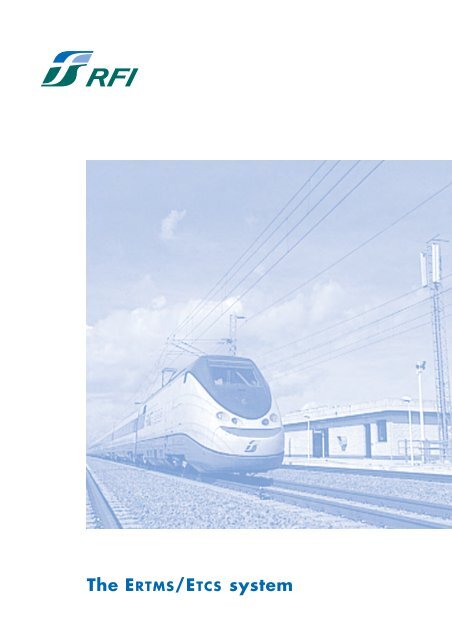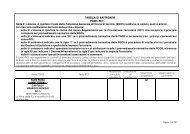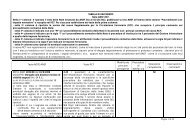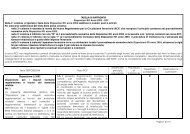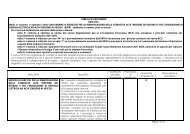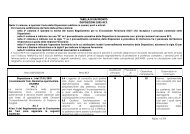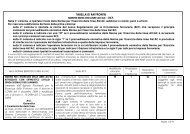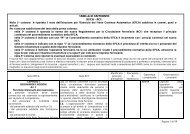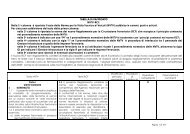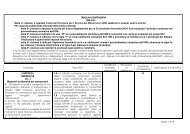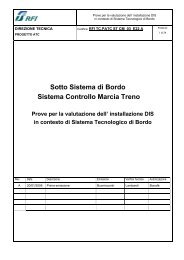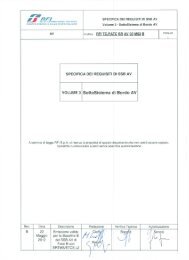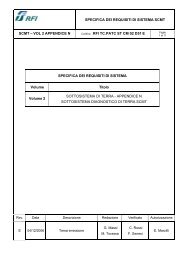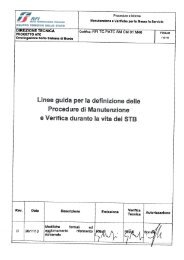The ERTMS/ETCS system
The ERTMS/ETCS system - Rfi
The ERTMS/ETCS system - Rfi
Create successful ePaper yourself
Turn your PDF publications into a flip-book with our unique Google optimized e-Paper software.
<strong>The</strong> <strong>ERTMS</strong>/<strong>ETCS</strong> <strong>system</strong>
THE DEVELOPMENT OF <strong>ERTMS</strong>/<strong>ETCS</strong> AND ITS IMPLICATIOItalian railways were among the first in Europe to adopt the European RailTraffic Management System/European Train Control System (<strong>ERTMS</strong>/<strong>ETCS</strong>)Level 2 on the new High-Speed/High Capacity network.<strong>ERTMS</strong>/<strong>ETCS</strong> has been installed to guarantee interoperable trafficon the European railway network; it is a <strong>system</strong> that is capableof guaranteeing train safety, thanks to the adoption of state-of-the-arttechnologies and functionality.Trials are currently being conducted with the <strong>ERTMS</strong>/<strong>ETCS</strong> Level 2 <strong>system</strong>,without any fall-back <strong>system</strong>s or line-side signallingon the Rome-Naples High-Speed/High Capacity line which will be broughtinto commercial operation next year.<strong>The</strong> <strong>ERTMS</strong>/<strong>ETCS</strong> standard, which is one of the most significantinnovations to have been introduced into the railway field,makes it possible for trains of different nationalities to travelthroughout the network sharing a common information base definedusing a common language, managed using common interoperableground and on-board constituents.More specifically, the standard defines the procedures for the groundand on-board exchange of signalling information betweenthe ground-based and on-board equipment, identifying the transmissiontechniques to be used and the message format.<strong>The</strong> ground-based and on-board <strong>ERTMS</strong>/<strong>ETCS</strong>basically removes the constraints on internationaltrain traffic caused by the differences betweenthe present <strong>system</strong>s in different countries.<strong>The</strong> <strong>ERTMS</strong>/<strong>ETCS</strong> <strong>system</strong> provides the driver,in a standard format, with all the information neededfor optimum driving, constantly controllingthe effect of every action taken in terms of train safety,and activating emergency braking should the train speedexceed the maximum safety limits.2
NS FOR RAILWAY INTEROPERABILITYRFI’s Industrial MissionRete Ferroviaria Italiana, the Ferroviedello Stato Group’s infrastructure company,operates under a government franchise,and relations with the governmentare regulated by the Programme Contractwhich lays down the investmentsthat RFI is required to make.RFI has been given the task of identifying,studying and implementingthe development of railway infrastructurein order to optimise the network’s capacityoffering, developing infrastructure use,offering train traffic servicesand other complementary services,and allocating and regulatingnetwork access.RFI also keeps the rail infrastructurein efficient working order,maintaining and renewing itand guaranteeing the highest possiblestandards in terms of quality and safety.In a liberalised and deregulatedtransport market scenario,like Italy’s, RFI’s roleas the infrastructure manager includesresponsibility for issuing the SafetyCertificate to operating companieswithout a license(granted by the Ministry of Transport)after ascertaining that they meetall the statutory eligibilityrequirements.It also gives the operating companiesaccess to the infrastructure,and markets the lines, levyingand collecting the toll charges.In incorporating RFI,the Ferrovie dello Stato Groupimplemented the EU directiverequiring network managementand train operation to be entrustedto separate companies.
How did we reach <strong>ERTMS</strong>/<strong>ETCS</strong>?Following the decision taken by the transport ministersin December 1989 a group of railway expertsbegan studying the fundamental requirementsfor a European interoperable <strong>system</strong>and defining the Project Declaration(the UIC-ERRI-S 1069 study group).<strong>The</strong> <strong>ERTMS</strong>/<strong>ETCS</strong> <strong>system</strong> tracksidetransmission baliseFigure 1<strong>The</strong> <strong>ERTMS</strong>/<strong>ETCS</strong> block <strong>system</strong> set out in the Project DeclarationSpotdata transmissionFixed infoDiscontinuousdata transmissionContinuousdata transmissionTrack-sideTrain-sideTransmitterand receiverReceiver/InterrogatorInterfaceLZBTVMOtherfunctionsKVBTrain integrityRoute map<strong>ETCS</strong> processorInterfaceTBLZUB<strong>ETCS</strong> busBACCInterfaceadometer unitInterfacerecording unitATP/ATCdriver interfaceServicebrake interfaceEmergencybrake interface…4
In June 1991, the industry (EUROSIG)and the railways (UIC) agreed on the principlesfor pursuing collaboration to developnew equipment for the European controland command <strong>system</strong> based on the ERRI-UICspecifications.<strong>The</strong> agreement made provision for the development of a new onboard display (EUROCAB),a new discontinuous ground-to-train transmission <strong>system</strong> (EUROBALISE),and a new continuous ground-to-train transmission <strong>system</strong> (EURORADIO).After the definition of the <strong>ERTMS</strong>/<strong>ETCS</strong> Master Planby the Commission, in 1995 the French, Germanand Italian railways jointly founded the EuropeanEconomic Interest Group <strong>ERTMS</strong>/<strong>ETCS</strong> Users Group(EEIG-<strong>ERTMS</strong>/<strong>ETCS</strong> Users Group).<strong>The</strong> Spanish, British and Dutch railways subsequentlyjoined the Group.<strong>The</strong> purpose of the EEIG (which is also knownby the French acronym GEIE) was to finalisethe <strong>ERTMS</strong>/<strong>ETCS</strong> specifications produced by the UICand to manage trial sites in France, Germany and Italy.Under Article 155 of the Treaty institutingthe European Community,which provides that all the citizens of the Union,businesses and national and regional authoritiesmust be able to fully benefit from the advantagesprovided by an area without internal borders,it was decided to establish the conditionsfor guaranteeing more efficient internationaltrain circulation by issuing a Europeaninteroperability directive.5
<strong>The</strong> interoperability directive for the High-Speed network<strong>The</strong> European Council held on 23 July 1996 adoptedCouncil Directive 96/48/ECof 23 July 1996 on the interoperabilityof the trans-European High-Speed rail <strong>system</strong>,as the instrument for removing the technological barriersto rail traffic at national borders.In order to define the solutions to meet the criterialaid down in the directive the European Union commissionedthe AEIF (European Association for Railway Interoperability)to draft the Technical Specifications for Interoperability (STIs)for High-Speed Rail.<strong>The</strong> railway administrations and the industries worked together within AEIFto develop the STIs, laying down the essential requirements(safety, reliability, health, worker protection, technical compatibility, operations),the interoperability components and interfaces, the European proceduresfor evaluating conformity/suitability of use, the functional and technical specifications,and the migration strategy for interoperability.<strong>The</strong> solutions laid down for interoperabilitymust be applied in all new applicationsand when the EuropeanHigh-Speed network lines are renewed.In 2001 a new interoperability directivewas adopted (2001/16/EC) for the conventional rail <strong>system</strong>.<strong>The</strong> Article 21 Committee approved the Technical Specificationsfor the Interoperability of the Control-Command Systemrelating to the new directive on 23rd November 2004.<strong>The</strong> essential element of the STIs for the conventional <strong>system</strong>is the adoption of the <strong>ERTMS</strong>/<strong>ETCS</strong> requirementsinto the specifications with small adjustments to the contents which,through the Change Control Management processwill also be introduced into the STIsfor the High-Speed rail <strong>system</strong> currently adopted.6
SundsvallOsloHelsinkiSt. PetersburgEdinburghGlasgowGothenburgStockholmTallinnRigaDublinMoscowCopenhagenVilniusRennesLondonParisAmsterdamBrusselsLuxembourgHamburgBerlinHannoverCologneDresaFrankfurtPragueNurembergGdanskWarsawLvivKatowiczMinskKievMunichViennaBordeauxLyonZurichGenevaInnsbruckMilan VeronaBratislavaLjubljanaBudapestAradChisinauLisbonPortoSevilleMadridBarcelonaValenciaMarseilleTurinVeniceTriesteGenoa BolognaRomeNaplesZagrebBelgradeSarajevoSkopjeBariTiranaCraiovaBucharestSofiaPlovdivCostanzaIstanbulAnkaraMalagaReggio CalabriaAthensWith the new directive the Migration process has takenon a major role regarding the criticalities associatedwith the use of <strong>ERTMS</strong>/<strong>ETCS</strong> on existing conventional track.A great effort is currently being deployedto harmonise the overall migration plans of the European networks.Discussions are in progress on the priority criteriaand the optimum methods,also in terms of the cost benefit analysis (CBA),to create an interoperable networkmade up of the main corridors as identified within the TEN network.A map of the corridors recently agreed upon appears above.7
WHAT IS <strong>ERTMS</strong>/<strong>ETCS</strong>?<strong>ERTMS</strong>/<strong>ETCS</strong> is the European <strong>system</strong>for automatically controlling train movementand is the solution identified by Europe’s railwaysand industries for achieving rail interoperability.<strong>The</strong> specifications of the requirements are public,and define the so-called kernel and its interfaces withthe ground-based and on-board equipment.<strong>The</strong> current specifications are <strong>ERTMS</strong>/<strong>ETCS</strong> Class 1published in the European Journal in 2000.At the present time the specifications are currently being consolidated by modifyingand supplementing them in order to remove any errors and ambiguitiesthat emerged in the trial stages and in the commercial applications of <strong>ERTMS</strong>/<strong>ETCS</strong>.<strong>The</strong> responsibility for appraising the admissibility of requestsfor modifications/supplements to the specifications and for indicating the waysin which they are to be incorporated into the existing specifications lies,as laid down in the process for the AEIF Change Control Management (figure 2),with the Board and the Steering Committee.Generally speaking, the technical aspects of the requestsfor modifications and supplements made by railway networksare analysed in advance by the EEIG <strong>ERTMS</strong>/<strong>ETCS</strong> Users Group,which also provides its input to the CCB AEIF.Decisions regarding requests for changes producedby the CCSC AEIF are formally submitted to the Article 21Committee (the official representatives of the EU member states)for final adoption so that they can be publishedin the Official Journal of the European Union.<strong>The</strong> modified version of the specifications publishedin the Official Journal totally replaces the previous version.8
Particularly important is the SystemRequirements Specification (SRS)which describes the <strong>ERTMS</strong>/<strong>ETCS</strong> kernelcomprising the whole EUROCAB, the interface equipmentwith the GSM-R, the data transmission equipmentwith EUROBALISE, EUROLOOP and EURORADIO,and the interface with the lineside signalling <strong>system</strong>s(interlocking, signals)and other on-board <strong>system</strong>s (braking <strong>system</strong>s).Figure 2Change Control Management flow chartAEIF Change ControlCCSCAEIFBoardECArt. 21AEIF C.C.M.CCAAEIFCSGSSG Control/CommandOther SSGPublicationin the OfficialJournalCCBC R authorChangeRequestCCAAEIFCSGSSG Control/Command
<strong>ERTMS</strong>/<strong>ETCS</strong> functionalityIn conceptual terms, the functionality of <strong>ERTMS</strong>/<strong>ETCS</strong> can be summarised in the figure 3 flow chart.<strong>The</strong> ways in which the train can receive lineside information dependson the application level chosen for the <strong>ERTMS</strong>/<strong>ETCS</strong>.Figure 3<strong>ERTMS</strong>/<strong>ETCS</strong> functionalityBraking if current speedexceeds the one definedby the dynamic speed profileLine-side datavia radio,balise, STMPositioningof trainand evaluationof the speed static profileSpeed comparisonDynamic speed profile(current safety speed)Current train speedTrainborne dataDisplayof DMI information<strong>The</strong>re are three levels of application.Application level 1 (figure 4) usesa discontinuous type of transmission <strong>system</strong> for onboard transmissionof data from the ground station using fixed balisesor switchable balises appropriately positionedand linked to the signalling <strong>system</strong>swhich constitute the information source (signals).<strong>The</strong> information and their coding method and their allocationin the telegram transmitted by the baliseare standardised to comply with <strong>ERTMS</strong>/<strong>ETCS</strong> specifications.10
Figure 4<strong>ERTMS</strong>/<strong>ETCS</strong> level 1 diagram<strong>ERTMS</strong>/<strong>ETCS</strong>LEVEL 1BaliseantennaLEUSwitchablebaliseFixedbalise<strong>The</strong> train position is determinedby the conventional train position detection <strong>system</strong>s (track circuits).<strong>The</strong> onboard software manages the functionality describedin the diagram shown in figure 3 with the available linesideand onboard information.Application level 2 (figure 5) usesa continuous type of transmission <strong>system</strong>for the onboard transmission of lineside datathrough safe radio links betweena Radio Block Centre (RBC) and the train.Figure 5<strong>ERTMS</strong>/<strong>ETCS</strong> level 2 diagram<strong>ERTMS</strong>/<strong>ETCS</strong>LEVEL 2LEVEL 1BaliseantennaEQUIPMENTFixedbalise11
<strong>The</strong> Radio Block Centresare linked to signalling unitsforming the data source(central equipment).Antennas linked to the Radio Block Centreat appropriate places along the lineare used for transmission.<strong>The</strong> information in the radio messagesand their coding method and allocationin the telegram transmittedare standards definedin the <strong>ERTMS</strong>/<strong>ETCS</strong> specifications.Also for <strong>ERTMS</strong>/<strong>ETCS</strong> level 2, the position of the trainsis determined by the conventional positiondetection <strong>system</strong>s (track circuits)while the onboard software managesthe functionality that is similar to the one described in figure 3,using available ground-based data(of the same type, but better defined and more promptly suppliedthan at level 1) and train-borne data.<strong>The</strong> GSM-R <strong>system</strong> used for track-train transmission is now being installedalong all the lines in the basic network, border crossings and the High Speed networkunder construction (7,500 kilometres of network to be covered by 2006-2007).<strong>ERTMS</strong>/<strong>ETCS</strong> level 2 requires the trainto be capable of travelling on lines equippedwith both <strong>ERTMS</strong>/<strong>ETCS</strong>level 2 and level 1.12
An <strong>ERTMS</strong>/<strong>ETCS</strong> application level 3has also been defined,even though it has not yet been brought into use.This does not use the traditional devices to detect train positions.<strong>The</strong> train position is detected on-board,and only calibration balises are installed track side.For this solution, train integrity must be guaranteed,but this is a problem that is still far from having been satisfactorily resolved.With the adoption of the mobile blockwhich is no longer linked to sections of the linebut to the real position of the moving train,level 3 makes it possible to establish the optimum distance between trains.This is another aspect that still leaves many problems unanswered,including those relatingto the impact on operating rules and standards.<strong>ERTMS</strong>/<strong>ETCS</strong> trains with the national <strong>system</strong>’s Specific Transmission Module (STM)installed on-board can travel along the lines that are equipped with this <strong>system</strong>.STM equipment can provide <strong>ERTMS</strong>/<strong>ETCS</strong> with standard informationtaken from the information in the ground-based national <strong>system</strong>sand make it possible for the national <strong>system</strong>’s services to be used.A summary of the equipment neededfor the different <strong>ERTMS</strong>/<strong>ETCS</strong> application levelsis given in table 1.Table 1<strong>ERTMS</strong>/<strong>ETCS</strong> equipmentOn boardTrack-side<strong>ERTMS</strong>/<strong>ETCS</strong> Check Data transmission Lineside Lineside Track Radioblocklevel of train electronic signals occupancyintegrity units detection1 no balises+loops (option) yes yes yes no2 no balises+radio no no yes yes3 (planned) yes balises+radio no no no yes13
<strong>ERTMS</strong>/<strong>ETCS</strong> DEVELOPMENT PLANS<strong>ERTMS</strong>/<strong>ETCS</strong> is considered to be the most appropriatetechnological signalling solution for the future.Equipping the new High Speed/High Capacity lineswith <strong>ERTMS</strong>/<strong>ETCS</strong> limits the useof the more dated national <strong>system</strong>sand prevents the development of new national <strong>system</strong>s.With the large-scale use of <strong>ERTMS</strong>/<strong>ETCS</strong>,apart from the resulting interoperability,train circulation safety is improved,particularly in countriesthat have more primitive signalling <strong>system</strong>s.For the conventional lines,on which Austria and a number of Eastern European countriesare extensively installing <strong>ERTMS</strong>/<strong>ETCS</strong> level 1,the highest priority set outin the European transport policy documentsis to establish interoperabilityin the so-called international corridors,firstly at the technical leveland then at the operating regulation level.Within the next five years a number of international corridors will become interoperable,at least at the technical level, thanks to the adoption of trackside and on-board <strong>ERTMS</strong>/<strong>ETCS</strong>as an alternative and/or in addition to the pre-existing <strong>system</strong>s.Spain, Belgium, France, Italy, Germany, the Netherlands, Sweden, Switzerland,Austria, Bulgaria, Hungary, Luxembourg and Romaniaexpect to introduce <strong>ERTMS</strong>/<strong>ETCS</strong> on most of their networks.<strong>The</strong> main applicationsbeing implemented or plannedfor the European High Speed networkare listed in table 2.14
Table 2<strong>ERTMS</strong>/<strong>ETCS</strong> Applications for the European networkCountry Year Line LevelSpain 2003 Madrid-Lleida 1 e 2Germany 2004 Ludwigsfelde-J-H/L 2Italy 2005 Rome-Naples 2UK 2005 WCML 1 e 2Netherlands 2005 Betuwe Lin 2France 2006 TGV Est 2Netherlands 2006 HSL-Sud 2Italy 2008 Milan-Bologna 2Italy 2008 Bologna-Florence 2Italy 2008 Milan-Turin 2Italy 2010 Milan-Venice 2<strong>ERTMS</strong>/<strong>ETCS</strong> for the Rome-NaplesHigh Speed/High Capacity line<strong>The</strong> Rome-Naples HS/HC line has been builtusing the <strong>ERTMS</strong>/<strong>ETCS</strong> level 2 <strong>system</strong>, without fall-back <strong>system</strong>s.This decision was taken as a result of the interoperability directive which providesthat the new HS lines should be equipped with <strong>ERTMS</strong>/<strong>ETCS</strong>, guaranteeing high standardsof operating safety on the national railway network, which is already one of the best in Europe,and optimum traffic management.On the HS/HC lines, train distancing, drivers cab signalling and ensuringdrivers’ compliance with all the procedures will be guaranteedby the <strong>ERTMS</strong>/<strong>ETCS</strong> level 2 equipment.For the HS/HC lines will not be equipped with linesidesignalling lights which are difficult to interpret the high speeds.<strong>The</strong> drivers will operate their trains under full supervisionbased exclusively on the information displayed on board.If the maximum permitted speed is exceeded, the <strong>system</strong> immediately activates the emergencybraking <strong>system</strong> and guarantees that the train will stop before the protected point is passed.15
<strong>ERTMS</strong>/<strong>ETCS</strong> level 2’s ground technology comprises a central unit, the so-called Radio Block Centre(RBC) installed in specific central posts from which railway circulation is managedand controlled through the System of Command and Control (SCC).<strong>The</strong> RBC continuously transmits to every train, via GSM-R radio, the speed and the train distanceto be observed depending on the position of all the trains present on the line (train distancing)and the constraints imposed by the track, or by any temporary slowdowns at that particular moment.At the same time, the trains send out radio signals indicating their position to the central unit.On the basis of the state of the infrastructure (free line, routesin the stations, train speeds, slowdowns) and the position of the train,the RBC transmits authorisation to proceed data to the on-train unit,giving details of the free distanceand the maximum permitted speed at the point.Figure 6<strong>ERTMS</strong>/<strong>ETCS</strong> block diagramTrain integrityTOUTIUSpecific TrainEquipmentJuridicalJuridical recorderrecorder<strong>ERTMS</strong>/<strong>ETCS</strong>KERNEL KERNELMMISTM Balise RadioLoopON BOARDAIR – GAPBaliseRadioRBCTRACK-SIDEExisting <strong>system</strong>sLoop16
<strong>ERTMS</strong>/<strong>ETCS</strong> level 2 is characterised, in terms of its onboard technology,by safety equipment which enables the driver to proceed based solely on the RBC informationto the onboard EVC (European Vital Computer) sub<strong>system</strong> posted on a screenforming part of the Driver Machine Interface (DMI).An <strong>ERTMS</strong>/<strong>ETCS</strong> block diagram is shown in figure 6.Figure 7<strong>The</strong> DMI screen<strong>The</strong> DMI (figure 7) is the European-standarddisplay which not only provides the driverwith information on the actual speedand the free downline distance,but also with continuous dataon the maximum permitted train speed.Using this information (Full Supervision),the onboard sub<strong>system</strong> takesall the appropriate action neededto guarantee the safety of the moving train(operating the braking control <strong>system</strong>if the driver fails to take action).<strong>ERTMS</strong>/<strong>ETCS</strong> level 2 uses the GSM-Railway (figure 8) <strong>system</strong> for communicationsbetween ground staff and on-board staff.In its railway version, GSM-R enables voice communicationsand data transmissions for train travelling safety purposes.Figure 8Diagram of the GSM-R functional architectureTrain to baseRadioshuntingE RTMSTrain controlTunnelscoverageAncillaryservicesYard RadioWorksandmaintenance<strong>The</strong> GSM-R radio network project forms part of the agreementswhich the Ferrovie dello Stato Group has concluded within the UIC to lay downcommon and interoperable standards with the other European networks.17
RFI’s migration strategy<strong>The</strong> application of the <strong>ERTMS</strong>/<strong>ETCS</strong> <strong>system</strong> both to the High-Speed linesand to the traditional network and border crossings forms part of the technological renewalsprogramme of RFI, the Ferrovie dello Stato Group’s infrastructure company.<strong>The</strong> migration strategy, which the Ministry of Transport officially notified to the EuropeanCommission when the STI CC came into force, makes provision for the following:“<strong>The</strong> High-Speed lines currently under construction (Rome-Naples, Florence-Bologna,Bologna-Milan, Turin-Milan), which are scheduled to be brought into commercial service between2005 (Rome-Naples) and 2008, and the other High Speed lines currently in the design stage(Milan-Venice, and the third Giovi border crossing) will all be equipped with <strong>ERTMS</strong>/<strong>ETCS</strong> level 2”.<strong>The</strong> new High-Speed trains will be equipped with <strong>ERTMS</strong>/<strong>ETCS</strong> level 2,and with the national STM for the <strong>system</strong>s that are set outin schedule B of the TSI Control Command to ensureinternal interoperability both with the conventional network linesand with the existing Rome-Florence High Speed line,until it is equipped with <strong>ERTMS</strong>/<strong>ETCS</strong> level 2, as scheduled.“<strong>The</strong> border lines to be connected to the High-Speed network, which are necessaryfor European interoperability, will be equipped in the medium-termwith <strong>ERTMS</strong>/<strong>ETCS</strong> level 2, while keeping the national <strong>system</strong> as a fall-back <strong>system</strong>”.<strong>The</strong> existing <strong>system</strong>s, and those currently being implemented,will at all events make it possible for interoperable trainsequipped with national STM to circulate.“<strong>The</strong> main conventional network lines will be gradually equipped with <strong>ERTMS</strong>/<strong>ETCS</strong>in the longer term, based on the principles defined in chapter 7 of TSI Control Command”.“An indication of the network affected by interoperability and the migration to <strong>ERTMS</strong>is given in the annex map entitled Interoperable FS trans-European network(second decision 1962/96/EEC of the Parliament and the Council)” (figure 9).In order to hasten migration towards interoperability in the interoperable corridors identified in theTrans European Transport Network and defined as priorities in June 2003 by the high-level groupchaired by Karel Van Miert, possible technical options were examined that might reducethe times for the interoperability of these corridors, seeking also to harmonise the initiativesand the scheduling of the other networks affected by the same corridors, particularly Switzerland,Austria and France. One practicable short term solution for those border crossing lineswith a lower traffic capacity and commercial speeds could lead to integrating the functionalityof the national SCMT <strong>system</strong> without BACC with the functionality of the <strong>ERTMS</strong>/<strong>ETCS</strong> level 1<strong>system</strong> without infill. With this solution, by taking specific precautions, SCMT balises wouldalso be used by <strong>ERTMS</strong>/<strong>ETCS</strong>, and would make it possible for both national SCMT trainsto circulate, as well as interoperable <strong>ERTMS</strong>/<strong>ETCS</strong> trains with similar operating features.18
Figure 9Programme for the construction of the interoperable FS trans-European networkHigh Speed networkEquipped linesConventional networkFigure 10<strong>The</strong> dual functionality of EUROBALISE<strong>ERTMS</strong>/<strong>ETCS</strong>level 1European telegramOnboard <strong>ERTMS</strong>/<strong>ETCS</strong>Onboard SCMTTelegram SCMT250bit (Packet 44)1,023 bit <strong>ERTMS</strong> telegram<strong>ERTMS</strong>/<strong>ETCS</strong>level 1European telegramOnboardTrack sideMeetings arecurrently being heldwith the SwissRailways to organisetrials withthis solutionon a line on theItalian-Swiss border(probably the bordercrossing at Luino).<strong>The</strong> aim of thesetrials would showwhether this solutionwill make it possiblefor an interoperableSBB train to travelalong the RFI lineequipped in this waywithout havingto add the STMfor SCMT.<strong>The</strong> dual SCMT+<strong>ERTMS</strong>/<strong>ETCS</strong>functionality,guaranteedby EUROBALISE,is shownin diagrammaticform in figure 10.
It should be noted that if the trials on the experimental Italian-Swiss line are successful,this could be a solution for interoperability on the conventional network linesas well as on the lines linking the national HS/HC network into the European High-Speednetwork (including the border crossing lines with low traffic capacity and commercial speeds),and lines linking the basic conventional network to the national HS/HC network.For wherever it is planned to install SCMT on part of these lines, whether they are presentlyequipped with axle counter blocks or whether they are without any evolved signalling <strong>system</strong>s,it might be appropriate to plan such a solution from the outset.In order for this solution to become an interoperable <strong>ERTMS</strong>/<strong>ETCS</strong> standard,the <strong>ERTMS</strong>/<strong>ETCS</strong> specifications must introduce a modificationso that on-board <strong>ERTMS</strong>/<strong>ETCS</strong> with reduced functionality can be used,even if there is a full <strong>ERTMS</strong>/<strong>ETCS</strong> level 1 ground installation present.Full functionality onboard could also be obtained with a ground installation of <strong>ERTMS</strong>/<strong>ETCS</strong>level 1, whenever a correct infill functionality is introduced (through GSM-R or a loop).Figure 11Official map of the interoperable networkMilan-Domodossola (Berne)Milan-Chiasso (Zurich)Milan-Turin (Lyon)Verona-Brenner (Innsbruck)Milan-Alessandria-GenoaMilan-VeniceVerona-BolognaBologna-FlorenceMilan-BolognaFlorence-RomeRome-Naples<strong>ERTMS</strong>/<strong>ETCS</strong> lev.2 only<strong>ERTMS</strong>/<strong>ETCS</strong> lev.1 overposedOn SCMTHigh Speed networkEquipped linesConventional networkVery short term before 2005 Short term before 2009 Medium term before 2012Long term after 2012 (some other blue and yellow lines)20


